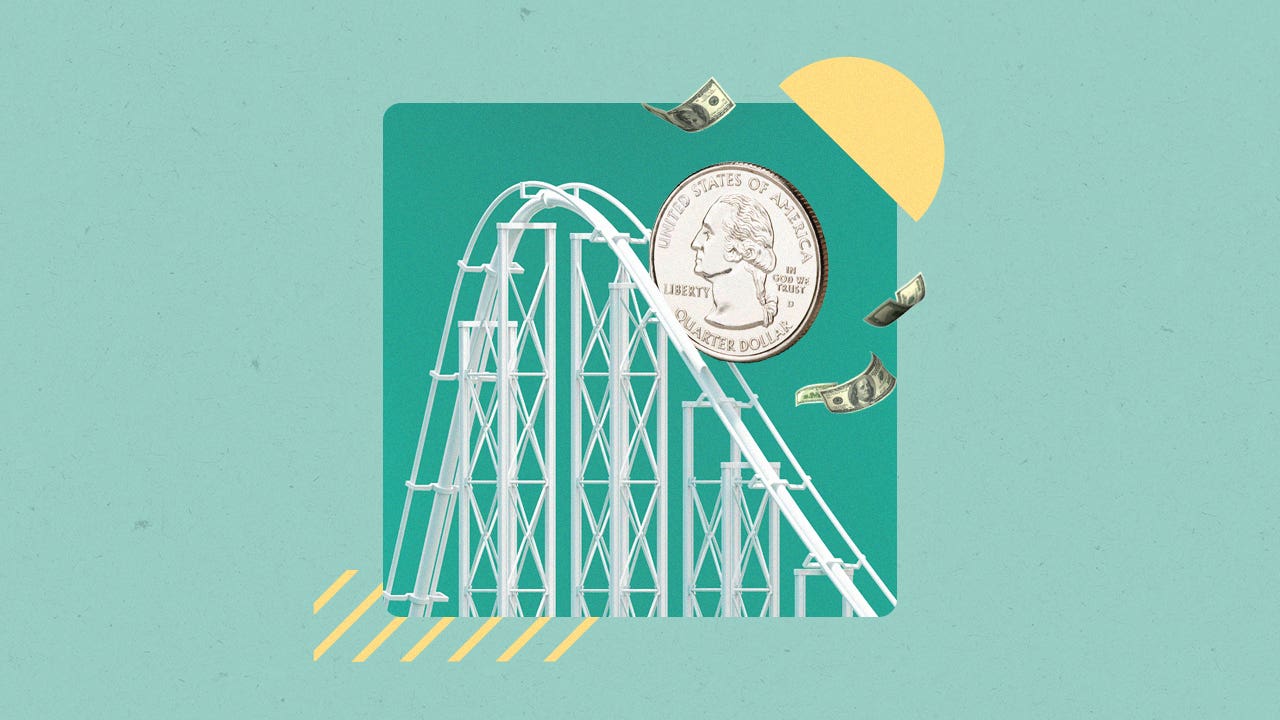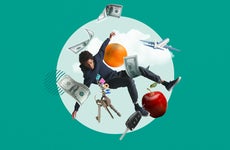Even after inflation cools, Americans could still be paying the price

The Bankrate promise
At Bankrate we strive to help you make smarter financial decisions. While we adhere to strict , this post may contain references to products from our partners. Here's an explanation for .
Prices are no longer rising at the fastest pace in four decades, and inflation is projected to slow even more this year.
That doesn’t mean Americans could immediately feel relief.
The massive post-pandemic price burst hasn’t just challenged consumers’ ability to afford the items they want and need. It’s also damaged their personal finances, making it harder for consumers to take the prudent financial steps that could set them up for success in the long run, recent Bankrate surveys suggest. Those steps include saving for emergencies, investing for retirement and covering expenses without incurring credit card debt.
More than two-thirds (or 68 percent) of adults are saving less for emergencies because of inflation, according to a Bankrate poll published in January, while nearly half (49 percent) in February said they have less savings or no savings compared to a year ago.
Having enough cash on the sidelines is the difference between covering an unexpected expense and taking on more high-interest debt. Yet, more than a third (or 36 percent) have more credit card debt than emergency savings, the highest on record since 2011, the February report found. At the same time, nearly half of Americans with credit card debt (48 percent) added more to their balances because of those price pressures, a CreditCards.com survey published in January found.
Inflation is also making it harder for Americans to pay their future selves. More than half (or 54 percent) of workers who didn’t increase their retirement contributions from the previous year said inflation was the reason why, according to a Bankrate study from October.
Those financial sacrifices Americans have made could mean the pain from inflation lingers — even when price increases eventually reach a more desirable level. By the end of this year, prices are expected to rise 3.6 percent from a year ago, projections from the U.S. central bank show.
As we’ve seen high inflation, many Americans have been forced to focus on needs over wants, with things like shelter, food and transportation occupying the highest spending priorities. As a result, some discretionary purchases or goals have been put on life’s back burner.— Mark Hamrick, Bankrate senior economic analyst
Key takeaways
- More than two-thirds (68 percent) are saving less for emergencies because of inflation. (Bankrate)
- Nearly half of Americans with credit card debt (48 percent) added more to their balances because of inflation. (CreditCards.com)
- Paying off credit card debt is becoming more difficult than ever, with the average credit card interest rate hitting a new record high of 20.11 percent on March 12. (Bankrate)
- More than half of workers who didn’t increase their retirement contributions from the previous year (54 percent) said inflation was the reason why. (Bankrate)
- Investing less for retirement can come with a cost. An individual who stopped investing for three years starting at 25 would miss out on almost $200,000 in retirement savings by the time they were 70, had they been investing $2,400 a year into their account at any other point. (Bankrate)
- Consumer prices in March rose 5 percent from a year ago but jumped 5.6 percent when excluding the more volatile food and energy costs, reflecting an inflation picture that’s slowly improving — but still stubbornly high. (BLS)
High inflation is costing Americans thousands of dollars — and not because the items they want and need are more expensive
Americans spent almost $400 extra a month to afford the same goods and services they purchased a year ago, according to a Moody’s estimate from January’s inflation data. But the cost of soaring inflation is likely much higher than that — particularly for those who’ve accumulated credit card debt or delayed retirement savings because of it.
Even a modest pullback in retirement contributions could come with a major cost that grows larger the younger you are. Someone who stopped investing at 25 for a three-year period to deal with inflation, for example, would miss out on almost $200,000 in retirement savings by the time they were 70, had they been funneling $2,400 a year into their account at any other point, Bankrate calculations show. Someone who did the same at 65, meanwhile, would miss out on about $9,000.
Credit card debt can also be a burden, and the rapid run-up in interest rates to quell inflation isn’t making the prospect of eliminating high-cost debt any easier. Someone with the average credit card balance of $5,910 would spend 25 years and almost $3,330 in interest if they could only afford to make the minimum payment until it was paid off, Bankrate’s credit card debt calculator shows. That estimate, however, assumes their credit card rate is near the national average of 20.21 percent. Many Americans could face even higher rates depending on their credit score and borrowing history.
“Getting caught in that credit card treadmill — that will be a long-term impact of this inflation environment,” says Faron Daugs, CFP, founder and CEO of Harrison Wallace Financial Group.
Americans have been taking on more debt than ever amid rising interest rates and high inflation. Household debt in February notched a new record of $4.82 trillion and has been on the rise since the pandemic in 2020, Federal Reserve data shows.
Making the picture worse, consumers have been drawing on the massive savings they built up during the coronavirus pandemic. Americans are now sitting on about $900 billion in excess savings, down from the record $2.1 trillion in 2021, according to a January analysis from J.P. Morgan Asset Management. Yet, lower-income Americans had mostly depleted those funds by December 2021, a Morgan Stanley analysis found.
Even when inflation cools, prices might not be any lower
Consumer prices in March rose 5 percent from a year ago, a massive slowdown from February’s 6 percent annual rate and 9.1 percent in June, according to the Department of Labor.
The slowdown shows higher interest rates are starting to do their job, though the pace of the slowdown hasn’t been as quick as the surge.
Fed Chair Jerome Powell has reiterated that the Fed’s primary goal with raising interest rates is bringing inflation back to a not-too-hot, not-too-cold sweet spot of 2 percent. The Fed judges that a little inflation is positive for the economy. Low and stable inflation signals that the U.S. economy is growing, workers can still get raises and businesses can keep expanding.
Yet, it highlights an important point for consumers: Inflation is expected to slow, but that doesn’t necessarily mean prices could fall across the board, a phenomenon that would mean deflation. And even once inflation returns to 2 percent, prices will be higher than they would’ve been — had the pandemic not occurred.
“Deflation is rare in America for any time longer than a year,” says Menzie Chinn, economics professor at the University of Wisconsin. “But over the last 30 years, we’re more accustomed to low inflation, rather than the inflation we’ve been seeing.”
That’s not to say consumers won’t see prices fall from where they are now in some corners of the economy — particularly among goods, energy and food. Consumers who regularly fill up their gas tanks, for example, are quick to notice prices rise and fall depending on the week.
Gasoline prices are 17.4 percent cheaper today than last March, according to the Department of Labor. Groceries are still up 8.4 percent from a year ago but fell 0.3 percent between February and March. Other products such as fruits, bacon, beef and pork have fallen in price from a year ago — reflecting early signs of food disinflation.
Electronics have also been leading the charge in disinflation since the latter half of 2022. Smartphone prices, for example, have dropped nearly 24 percent from a year ago, while televisions are 14 percent cheaper, the Labor Department found. Consumers are even feeling some relief across the nation’s car lots — where inflation first surged with a vengeance as shipping shortages and manufacturing setbacks clogged supply chains. Used car prices have dropped nearly 14 percent from a year ago and are at levels not seen since May 2021, according to the Labor Department.
Goods prices could fall, while services remain stickier
But services inflation might remain stickier, such as the price of eating at a restaurant, receiving medical care, repairing a car or getting a haircut. That’s because inflation in those categories largely depends on what’s happening within the labor market — and the service industry has been facing the tightest worker shortage.
Job openings have steadily decreased since the Fed started raising rates, hitting 9.9 million in February from a record high of 12 million in March 2022. Yet, 8.3 percent of positions within leisure and hospitality are still vacant, according to a Department of Labor report on labor turnover.
Employers have had to lift wages in those sectors to lure more talent. Compensation costs within the leisure and hospitality industry rose 6.5 percent in the last four months of 2022, compared with 5.1 percent for all other private industry workers, according to the Department of Labor’s employment cost index (ECI). Prices over the same four-month period rose 7.1 percent, consumer price index (CPI) data shows.
Wage growth is bound to keep slowing along with the economy and the job market, adding less pressure to ongoing rapid price increases.
“If their real wages are higher permanently, then you’re probably going to expect that restaurant prices tend to be higher for a long time,” Chinn says. “They’re not likely to come down.”
However, economists say pay and, consequently, inflation might not drop absent a steep recession that craters demand or employment. Prices have only declined during tougher economic times, such as during the 2001 dotcom-bubble downturn and the Great Recession of 2007-2009. Wishing for lower prices, however, might be a cure even worse than the disease, according to Tuan Nguyen, economist at RSM.
“Deflation can create a vicious cycle that discourages spending and investment, leading to a more severe type of recession,” he says.
Americans, however, could feel a difference when inflation slows because it gives their pay time to catch up. Part of the reason why inflation has been beating Americans down, more than half (or 55 percent) of employed adults said their income has not kept up with increases in household expenses due to inflation, according to a Bankrate report published in September. That’s even despite Americans seeing the fastest pay raises in more than two decades, according to data from the Department of Labor.
“Americans will feel good about inflation when they no longer have to think about it in their daily lives, as was the case during the ten-year period before the pandemic when inflation was almost negligible,” Nguyen adds.
The turning point depends on when inflation slows. Until then, more financial pain could lie ahead.
“One of the great unknowns is whether inflation might stick around higher for longer for quite some time to come, as many fear,” Hamrick says. “It will matter a great deal to Americans if key prices remain elevated since for many, their wages failed to keep up with inflation.”
Here are 8 tips for getting your finances back on track when inflation has been weighing you down
Americans trying to get ahead on saving and investing when prices are rising faster than their pay can feel like running for the exit in a room that keeps getting longer and longer. But remember: Economic disruptions are impossible to predict and can occur unexpectedly. It underscores the importance of constantly preparing your finances for high inflation, even during times when it remains low and stable.
You can’t control how much prices are rising, but you can control what you do about it with your finances — and even the smallest steps can help your wallet from taking a big hit. Here are 8 tips to help you get your finances back on track and limit how much inflation hurts you.
1. When inflation is high, be hyper-aware of your budget
Inflation feels like taking a pay cut. Suddenly, the dollars in your wallet don’t go as far as before, and you’re paying more for the same goods and services you usually purchase.
It’s always crucial to track your spending, but eras of high inflation underscore the importance even more. Consider setting a recurring “date” with yourself, at least once a week, where you analyze how much you’re spending, count your bills and track your recurring expenses.
The goal is to get a handle on your financial picture, but you might see easy places to cut back once you know where your money is going. Such examples could be cutting back on a streaming service or dining out one fewer time a week.
Anytime you eliminate a bill or a line in your budget, recycle that money into your emergency fund.
“One can reduce expenses, look to boost income or some combination,” Hamrick says. “Once those objectives have been achieved, this affords the opportunity to channel some of the savings in areas like saving for emergencies, putting more away for retirement, and paying down — or off — debt.”
2. Know where inflation is and isn’t
Another benefit of tracking your spending is you can easily compare the most common lines in your budget with official inflation rates.
Such knowledge could help you save more money down the line. It’s just like comparison shopping at different stores for furniture or appliances. If you know where prices are still rising, or where some may be rebalancing, you’ll be more informed about when’s the right time to make a purchase — and maybe when it could still be time to hold off.
One such example of where this tip could be powerful: Car lots. While used car prices have fallen in recent months, new vehicle prices are still climbing, rising 6.1 percent in March from a year ago, according to the Department of Labor.
You might also learn which of your purchasing habits make you especially fragile to inflation. Those who buy a carton of eggs or ice cream weekly, for example, might experience more inflation than others, with those items up a respective 36 percent and 15 percent from a year ago.
3. Take advantage of tools to help you eliminate your credit card debt
Borrowers saddled with high-cost credit card debt or variable-rate loans are hit hardest in a high-inflationary environment, mostly because of what happens congruently with inflation: rising interest rates.
A variable-rate loan makes you a sitting duck to rising rates because your borrowing costs increase per every rate hike. Credit card debt, meanwhile, is among the most expensive debt to have, and the average interest rate has continued to break records since the Fed started lifting rates last year.
Consider refinancing any variable-rate loans into a fixed rate and utilizing a balance transfer card for your credit card debt. Both processes come with a fixed fee for transferring your debt. Yet, it may be worth it in the long run if it helps you chip away at your debt even faster and limits how much you spend in interest each month.
If you have credit card debt, enact a plan to pay down that debt, and set a goal for yourself on how much toward that balance you want to pay a month. This might be a wise way to use some of that cash you freed up from eliminating any bills or expenses.
“The bottom line is, you built this credit card debt up, and it’s going to take patience and a little pain to get it back down to zero,” Daugs says. “But be patient, and have a plan.”
4. Find the right credit card for you — as long as you pay it off every month
If you don’t have credit card debt, spending more for the same amount of goods and services because of inflation can work in your favor if you use a card that matches your lifestyle and spending habits — and rewards you for it. If your most frequent purchases are gasoline or groceries, for example, you may be able to find a cash-back card that gives you money back.
The points you rack up can either be applied toward your bill or put to use in another way — potentially toward your “fun” fund.
5. Make sure your savings is losing as little purchasing power as possible
Saving isn’t easy when inflation is high, but make sure your cash is doing as much work for you as possible by keeping your money in an account with higher returns.
Interest rates at high-yield savings accounts are nearly 17 times higher than the national average, while being FDIC-insured. Even if you start with an initial deposit of $1,000 and add $20 each month over a year, you’d earn about $44 a year in interest compared to nearly $3 at your traditional brick-and-mortar bank.
The highest-yielding 5-year certificate of deposit (CD) is paying over 5 percent, the biggest payout in over a decade. If you have the cash and can spare locking it away, consider putting it where it’ll be protected, especially knowing inflation — and interest rates — are unlikely to be this high half a decade from now.
“It is true inflation is high, but it’s also true your savings rate is better,” says Lindsay Bryan-Podvin, a certified financial therapist who works with MetLife’s financial wellness money app, UpWise. “As humans, we are wired for a negativity bias, which means we are more likely to see the things we perceive to be bad or dangerous. We’d love to have positive associations, but sometimes the first step is just to have a neutral association.”
She points to more than two-thirds (or 67 percent) of workers in a 2022 MetLife study who said inflation was the top concern straining their financial health — and those who don’t feel financially healthy were more likely to feel less healthy mentally.
“It’s important to focus on what’s happening to you personally,” she adds. “We can’t control what happens weather wise. It’s the same when it comes to things like inflation.”
6. Even if it’s a small amount, prioritize investing for long-term goals
Even if retirement seems like decades away, the time to prepare for it is now — and investing is the one sure way to make sure your cash consistently beats inflation. The S&P 500 has had an average return of 10 percent per year over the past half a century.
Be sure to contribute some funds to an employer-sponsored, tax-advantaged retirement account — and even better if you can contribute up to your employer match, so long as your workplace offers one.
And even if you have to cut back by just a small amount on how much you’re investing for the long haul, it can make a major difference than just eliminating those contributions.
Had the 25-year-old investors who stopped investing for three years amid high inflation stayed the course and continued to contribute just $1,200 a year (or $100 a month), they’d miss out on about $99,000 in retirement funds by the time they reached 70 — much better than the $200,000 they would’ve missed out on by not investing at all for three years.
When prices fall or when you eliminate that high-cost debt, you might be able to make even greater gains for yourself and increase your contributions.
“Eighteen months will not make or break your retirement goal” if you have to hit the pause button, Daugs says. “But the goal there is, after that 18 months, you bump that 401(k) or retirement plan contribution back up to where it was — or even higher.”
7. Know that the adjustments you make don’t have to be forever
Inflation is detrimental to Americans’ finances because it makes it harder for consumers to buy the items they need — and want. You might not be able to afford as many vacations as you would have previously or may have to cut back on eating out for the time being, but know this era of high inflation won’t last forever. Nearly 9 in 10 (or 88 percent) of economists in Bankrate’s First-Quarter Economic Indicator poll say inflation is likely to decelerate within 12 to 18 months.
Little sacrifices now can help make sure your finances don’t take a greater dent down the road.
And if you shop around for the best deal and save in advance for the trips or purchases you want to make, remind yourself that it’s OK to treat yourself every once and a while.
“There’s this cognitive spiral that can happen — where the way we feel impacts the way we behave,” Bryan-Podvin says. “‘I just can’t save. I’m not good at it.’ We might feel a little bit embarrassed, a little bit of shame and avoidant. But experiencing those indifferent feelings may make us less likely to take action. Take a look at that thought and examine how true it is. ‘I might not be saving as much as I was two and a half years ago, but I’m still saving. I have started to put things on my credit card, but I also have a plan to pay it off.’”
8. When it comes to your finances, be easy on yourself and acknowledge your wins
You might have had to trim back on those all-important contributions to your retirement or savings account — and in this era of high inflation, remember that’s OK. Building the habit of paying yourself first is the most important step you can take, and it pays off the earlier you get started.
Giving yourself grace during this era of broad-based inflation can help ensure you maintain the positive associations with personal finance that lead to strong habits for years to come — whether inflation is at 2 percent or 5 percent.
“Be flexible when it comes to financial goals that change with inflation,” Bryan-Podvin says. “If you work hard on saving $100, and by the end of the month, you’ve saved $80 — instead of going, ‘I’m $20 short,’ the net positive here is, you still saved $80. Think about what is your happy medium and not comparing yourself to what life was like three years ago or even a year ago.”
Related Articles


Inflation slowed again in June but some items are still pricey — here’s what’s rising most

Red-hot inflation is raising prices on everyday essentials — here’s what’s rising the most

Survey: Inflation has likely peaked, but consumers will still pay more this year